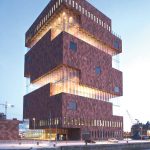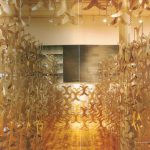
The scream that nobody hears depicted in the wide perfect circle as the mouth on the face
Very few people have the courage to voice publicly the truth behind the flaws of their society; in contradistinction, those who use their talents and skills for personal profit and gain are legion. Artist Jagath Weerasinghe belongs to the former category as he uses his passion for art to communicate his subconscious thoughts of an unforgiving human society. He is an artist who believes that purity in one’s profession can only result from being true to one’s self. It is this conviction that has brought Jagath Weerasinghe from being a student of Fine Arts at the American University in Washington to become an iconic figure in the Artistic community of Sri Lanka and to a citizen with a passion towards social activism. What is interesting about Jagath is that not a single one of his paintings is painted and exhibited to promote his beliefs. He paints through deep self reflection, for himself and as a projection of his innermost emotions and thoughts on the social situations that surround him. It is in this endeavour that he and his work have become pivotal towards the development of a contemporary genre of art in Sri Lanka. He himself has become the forerunner for a contemporary movement that has elevated the artistic standards in this island nation andcarried it across the millennial divide into the 21st Century.
His work, however, is not simply a critique of society; it consists of numerous narratives of realities as seen through his eyes, of a society riddled with contradictions. Recurring motifs in his work are war, misrepresentation of religion and weapons of mass destruction, intertwined to reveal not only the significance of their presence but also the result of their involvement in the causality of violence through these seemingly unwarranted instances. This revelation in his thought process peaked during the infamous 1983 riots, as fragments of racism mixed with patriotism in his paintings and the guilt of such devotion towards these institutions ravaged his mind and darkened his soul. This period was short lived, however, as from the darkness arose a voice of truth which helped portray the realities of society in a densely rich pallet of watercolours and acrylics.
His work shifts between representations of fragmented elements on a single canvas and sole iconic elements. Fragmentation of the image as seen in Celestial Violence 1 and Celestial Violence 2 is used in order to create a visual impression of the chaos that accompanies violence, together with the idea that violence is somehow connected with divine intervention. Celestial Violence 1 shows knives hovering around the head of youth, where the knives have no owners giving the impression of having floated down from the heavens. They are clearly earthly elements; however the apparent lack of ownership clearly states that all these acts of violence in society exist with not a sole person willing to take responsibility. Similarly Celestial Violence 2 uses the gun as the symbol of brutality, with the wings attached against a background of clouds, depicting once again a religious motif as a cause behind the capacity of the firearm to wreak destruction.
These contrasting, nonrelated elements generate powerful messages concerning the subtle relationship between violence and the abuse of religion, enabling these fragmented chaotic ideas to unify in the mind’s eye of the observer to create a coherent social narrative. The culmination of this mode of aesthetic reasoning is showcased in his extensive collection of paintings of the Hindu god Shiva where the “Dance of Shiva” becomes symbolic of religion, violence and contemporary politics, since Shiva is the aspect of the Hindu godhead associated with death and destruction in the sense of destroying the ego and shedding of attachments that corrupt the mind. This is an elevated conceptualisation, quite in contrast to mundane notions of destruction, yet logical in thought as all that has a beginning must have an end. Given that contemporary politics creates death and destruction in the name of religion, it seems an appropriate personification, albeit with an ironic twist, as God Shiva’s intentions are quite antithetical to the inequities of a corrupt society. Equally symbolic are the single element depictions, “the knife series”, where several knives which at first seem sinister become then less so as when one realises that the image is that of a kitchen knife with its blade coated in multi-coloured stains.
The colours depict the various institutions and aspects of society that the blade has touched.
It is not an easy task to decipher the depth of the narrative when faced with one of Weerasinghe’s creations. At first sight his work, although thought provoking, is deeply disturbing. It is by completely immersing oneself in his creations that one becomes aware of his expressionistic skills: his every stroke, outline and use of colour have an embedded narrative behind their existence on canvas. As such, Jagath Weerasinghe’s oeuvre transcends mere aesthetic expression: it defines a place of being where no boundaries exist in the depiction of truth. As a consequence, it has become a medium with the potential to trigger social activism through the eyes of those who have witnessed his creations.



















